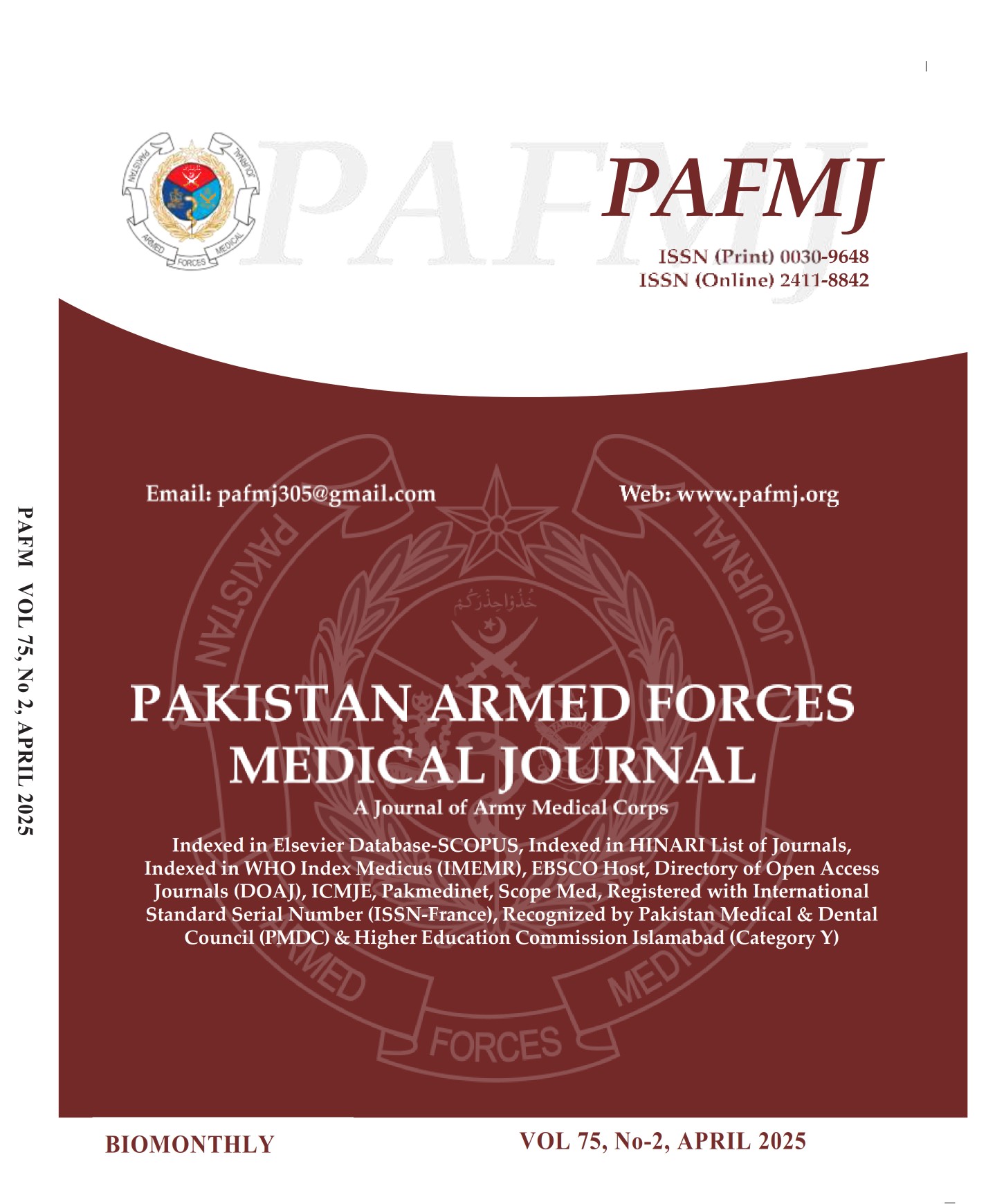Evaluation of Serum Zinc Levels Among Patient of Chronic Kidney Disease in a Tertiary Care Hospital
DOI:
https://doi.org/10.51253/pafmj.v75i2.7302Keywords:
Atomic Absorption Spectrometry, Chronic Kidney Disease, Zinc Deficiency.Abstract
Objective: To evaluate serum zinc levels in various stages of chronic kidney disease and to compare serum zinc levels in patients of chronic kidney disease undergoing and not undergoing hemodialysis.
Study Design: Cross-sectional study.
Place and Duration of Study: Department of Chemical Pathology and Endocrinology, Armed Forces Institute of Pathology, in collaboration with Armed Forces Institute of Urology, Rawalpindi, Pakistan from Jan to Jun 2021.
Methodology: Zinc levels of 120 individuals were analyzed on Flame Atomic Absorption Spectrophotometer and creatinine measured in serum samples. Patients were divided into five subgroups, stages 1-5, according to eGFR values. Zinc levels were expressed as Mean±SD. Independent sample t-test was used to compare serum zinc concentration of hemodialysis patients with non-hemodialysis patients and one-way ANOVA was used to compare zinc concentrations in patients with different stages of chronic kidney disease.
Results: Mean age of patients was 58±17 years. Mean value of serum zinc level was 9.03±2.51 µmol/L. The level of serum zinc showed a statistically significant difference (p=0.005) at different stages of disease, with significant decreasing trend in late-stage chronic kidney disease. We found a significant difference in mean serum zinc level among hemodialysis and non-hemodialysis individuals.
Conclusion: Patients of chronic kidney disease showed significant difference in serum levels of zinc across different stages. We found an increasing trend of zinc deficiency as the disease progressed, as well as with hemodialysis dependency.
Downloads
References
Lobo JC, Torres JP, Fouque D, Mafra D. Zinc deficiency in chronic kidney disease: is there a relationship with adipose tissue and atherosclerosis? Biol Trace Elem Res 2010; 135(1): 16-21. https://doi.org/10.1007/s12011-009-8504-9
Plum LM, Rink L, Haase H. The essential toxin: impact of zinc on human health. Int J Environ Res Public Health 2010; 7(4): 1342-1365.
https://doi.org/10.3390/ijerph7041342
Shih CT, Shiu YL, Chen CA, Lin HY, Huang YL, Lin CC. Changes in levels of copper, iron, zinc, and selenium in patients at different stages of chronic kidney disease. Genom Med Biomark Health Sci 2012; 4(4): 128-130.
https://doi.org/10.1016/j.gmbhs.2013.03.001
Nakatani S, Mori K, Shoji T, Emoto M. Association of zinc deficiency with development of CVD events in patients with CKD. Nutrients 2021; 13(5): 1680.
https://doi.org/10.3390/nu13051680
Hasan M, Sutradhar I, Gupta RD. Prevalence of chronic kidney disease in South Asia: a systematic review. BMC Nephrol 2018; 19(1): 291.
https://doi.org/10.1186/s12882-018-1072-5
Alqabbani HM, AlBadr NA. Zinc status (intake and level) of healthy elderly individuals in Riyadh and its relationship to physical health and cognitive impairment. Clin Nutr Exp 2020; 29(1): 10-17.
https://doi.org/10.1016/j.yclnex.2019.12.001
Maruyama Y, Nakashima A, Fukui A, Yokoo T. Zinc deficiency: its prevalence and relationship to renal function in Japan. Clini Exp Nephrol 2021; 25(2): 771-778.
https://doi.org/10.1007/s10157-021-02046-3
Ribeiro RC, Sales VS, Neves FD, Draibe S, Brandão-Neto J. Effects of zinc on cell-mediated immunity in chronic hemodialysis patients. Biol Trace Elem Res 2004; 98(1): 209-217.
https://doi.org/10.1385/BTER:98:3:209
Konz T, Santoro A, Goulet L, Bazzocchi A, Battista G, Nicoletti C, et al. Sex-specific associations of blood-based nutrient profiling with body composition in the elderly. Physiol 2019; 9(1): 1935. https://doi.org/10.3389/fphys.2018.01935
Tokuyama A, Kanda E, Itano S, Kondo M, Wada Y, Kadoya H, et al. Effect of zinc deficiency on chronic kidney disease progression and effect modification by hypoalbuminemia. PLoS One 2021; 16(5): e0251554.
https://doi.org/10.1371/journal.pone.0251554
Prasad AS. Lessons learned from experimental human model of zinc deficiency. J Immunol Res 2020; 2020(1): 9207279.
https://doi.org/10.1155/2020/9207279
Cardozo LF, Mafra D. Don’t forget the zinc. Nephrol Dial Transplant 2020; 35(7): 1094-1098.
https://doi.org/10.1093/ndt/gfaa045
Damianaki K, Lourenco JM, Braconnier P, Ghobril JP, Devuyst O, Burnier M, et al. Renal handling of zinc in chronic kidney disease patients and the role of circulating zinc levels in renal function decline. Nephrol Dial Transplant 2020; 35(7): 1163-1170. https://doi.org/10.1093/ndt/gfz065
Takic M, Zekovic M, Terzic B, Stojsavljevic A, Mijuskovic M, Radjen S, et al. Zinc deficiency, plasma fatty acid profile and desaturase activities in hemodialysis patients: is supplementation necessary? Front Nutr 2021; 8(2): 700450.
https://doi.org/10.3389/fnut.2021.700450
Okamoto T, Hatakeyama S, Konishi S, Okita K, Tanaka Y, Imanishi K, et al. Comparison of zinc acetate hydrate and polaprezinc for zinc deficiency in patients on maintenance hemodialysis: A single‐center, open‐label, prospective randomized study. Ther Apher Dial 2020; 24(5): 568-577.
https://doi.org/10.1111/1744-9987.13461
Nishime K, Kondo M, Saito K, Miyawaki H, Nakagawa T. Zinc burden evokes copper deficiency in the hypoalbuminemic hemodialysis patients. Nutrients 2020; 12(2): 577.
https://doi.org/10.3390/nu12020577
Bozalioglu S, Ozkan Y, Turan M, Simsek B. Prevalence of zinc deficiency and immune response in short-term hemodialysis. J Trace Elem Med Biol 2005; 18(3): 243-249.
https://doi.org/10.1016/j.jtemb.2005.01.003
Barman N, Salwa M, Ghosh D, Rahman MW, Uddin MN, Haque MA. Reference value for serum zinc level of adult population in Bangladesh. Int Fed Clin Chem Lab Med 2020; 31(2): 117.
Downloads
Published
Issue
Section
License
Copyright (c) 2025 Kehkshan Waheed, Zujaja Hina Haroon, Afshan Bibi, Muhammad Amir, Sobia Irum Kirmani, Usman Munir

This work is licensed under a Creative Commons Attribution-NonCommercial 4.0 International License.















